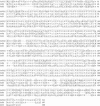Characterization of variant Salmonella genomic island 1 multidrug resistance regions from serovars Typhimurium DT104 and Agona
- PMID: 12019080
- PMCID: PMC127246
- DOI: 10.1128/AAC.46.6.1714-1722.2002
Characterization of variant Salmonella genomic island 1 multidrug resistance regions from serovars Typhimurium DT104 and Agona
Abstract
Strains of multidrug-resistant Salmonella enterica serovar Typhimurium DT104 (DT104) and S. enterica serovar Agona (Agona) have been found to harbor Salmonella genomic island 1 (SGI1), a 43-kb genomic region that contains many of the drug resistance genes. Such strains are resistant to ampicillin (pse-1), chloramphenicol/florfenicol (floR), streptomycin/spectinomycin (aadA2), sulfonamides (sul1), and tetracycline [tet(G)] (commonly called the ACSSuT phenotype). All five resistance genes are found in a 13-kb multidrug resistance (MDR) region consisting of an unusual class I integron structure related to In4. We examined DT104 and Agona strains that exhibited other resistance phenotypes to determine if the resistance genes were associated with variant SGI1 MDR regions. All strains were found to harbor variant SGI1-like elements by using a combination of Southern hybridization, PCR mapping, and sequencing. Variant SGI1-like elements were found with MDR regions consisting of (i) an integron consisting of the SGI1 MDR region with the addition of a region containing a putative transposase gene (orf513) and dfrA10 located between duplicated qacEDelta1/sulI genes (SGI1-A; ACSSuTTm); (ii) an integron with either an aadA2 (SSu) or a pse-1 (ASu) cassette (SGI1-C and SGI1-B, respectively); (iii) an integron consisting of the SGI1-C MDR region plus an orf513/dfrA10 region as in SGI1-A (SGI1-D; ASSuTm; ampicillin resistance due to a TEM beta-lactamase); and (iv) an integron related to that in SGI1 but which contains a 10-kb inversion between two copies of IS6100, one which is inserted in floR (SGI1-E; ASSuT). We hypothesize that the MDR of SGI1 is subject to recombinational events that lead to the various resistance phenotypes in the Salmonella strains in which it is found.
Figures



References
-
- Arcangioli, M. A., S. Leroy-Setrin, J. L. Martel, and E. Chaslus-Dancla. 1999. A new chloramphenicol and florfenicol resistance gene flanked by two integron structures in Salmonella typhimurium DT104. FEMS Microbiol. Lett. 174:327-332. - PubMed
-
- Boyd, D. A., G. A. Peters, A. Cloeckaert, K. S. Boumedine, E. Chaslus-Dancla, H. Imberechts, and M. R. Mulvey. 2001. Complete nucleotide sequence of a 43-kb genomic island associated with the multidrug resistance region of Salmonella enterica Typhimurium DT104 and its identification in phage type DT120 and serovar Agona. J. Bacteriol. 83:5725-5732. - PMC - PubMed
-
- Boyd, D. A., G. A. Peters, L.-K. Ng., and M. R. Mulvey. 2000. Partial characterization of a genomic island associated with the multidrug resistance region of Salmonella enterica Typhimurium DT104. FEMS Microbiol. Lett. 189:285-291. - PubMed
MeSH terms
Substances
LinkOut - more resources
Full Text Sources
Medical

